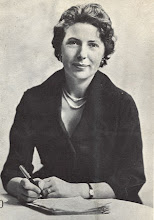Since Mary Stewart's books are so famous for their exotic and well-described settings, I thought it would be fun to find photos of those settings and post them here on the blog. I hope eventually to make my way through all the novels. I'm starting with
Madam, Will You Talk? The book's heroine, Charity Selborne, makes her way through much of southern France.
Le Pont d'Avignon
 photo
photo by
Navas"...presently, round a curve in the city wall, the old bridge of the song came into view, its four remaining arches soaring out across the green water to break off, as it were, in midleap, suspended halfway across the Rhone."
The Pont du Gard
 photo
photo by
Wolfgang Staudt"I suppose the ten or twelve minutes that David and Rommel and I spent gazing at those golden arches spanning the deep green Gardon were like the last brief lull before the thunder."
Nimes, the Temple of Diana
 photo
photo by
smithco"I left my chair and went through the crumbled arches into the tiny square of the temple. It was like being miles from anywhere. Behind me, back through the crumbled archway, was the hot white world with its people and its voices; here, within, was a little square of quiet and green coolness. Trees dripped over the high broken walls, shadows lay like arras in the pillared corners, fronds of ferns lent softness to every niche and crevice."
Les Baux
 photo
photo by
kahala"The deserted town of Les Baux, in medieval times a strong and terrible fortress, stands high over the southern plains....The prospect is wild enough, and strange enough, to satisfy anyone who, like myself that evening, felt so pressingly the need for quiet and my own company."
Marseilles, Chateau d'If
 photo
photo by
Axel13000"I sat on the low parapet of the turret of the Chateau d'If watching the white stone slowly flush to a tender rose. I watched the softly breaking water of the tideless sea wash and wash cross the whispering white pebbles, aquamarine rippled through with liquid gold."
The port of Marseilles
 photo
photo by
bfalk"Presently we found ourselves in a cobbled street which slanted along the sea front, with tall houses to the left of us, and a low sea-wall to the right. Away ahead, floating in the starlit air like a vision, glimmered the gold statue of Our Lady who stands on the high summit of Notre Dame de la Garde."
*All quotes are from Madam, Will You Talk? copyright 1955, Mary Stewart
**A note about the photos. All photos are from flickr--each attribution has links to the photo and the artist's profile. If you own one of these photos and would like it removed, simply let us know in the comments. Thanks!
 Barbara Michaels is a pseudonym of Barbara Mertz, who also writes historical fiction under the name Elizabeth Peters. Under the Michaels name she writes gothic suspense novels, which often have romantic threads running through them.
Barbara Michaels is a pseudonym of Barbara Mertz, who also writes historical fiction under the name Elizabeth Peters. Under the Michaels name she writes gothic suspense novels, which often have romantic threads running through them. Daphne du Maurier is most famous for Rebecca, which is an amazing book. I haven't read any of her others but mean to in the future.
Daphne du Maurier is most famous for Rebecca, which is an amazing book. I haven't read any of her others but mean to in the future. M.M. Kaye wrote a series of "Death in" books. Death in Kashmir, Death in the Andamans, etc. All feature young English women in exotic settings caught in dangerous situations. (She also wrote my favorite children's book of all time, The Ordinary Princess, which is not at all like anything Mary Stewart ever wrote but still fabulous.)
M.M. Kaye wrote a series of "Death in" books. Death in Kashmir, Death in the Andamans, etc. All feature young English women in exotic settings caught in dangerous situations. (She also wrote my favorite children's book of all time, The Ordinary Princess, which is not at all like anything Mary Stewart ever wrote but still fabulous.) Susanna Kearsley writes lovely suspense novels, some contemporary and some historical (and some a combination of both!). My favorites are The Shadowy Horses and The Winter Sea.
Susanna Kearsley writes lovely suspense novels, some contemporary and some historical (and some a combination of both!). My favorites are The Shadowy Horses and The Winter Sea.













